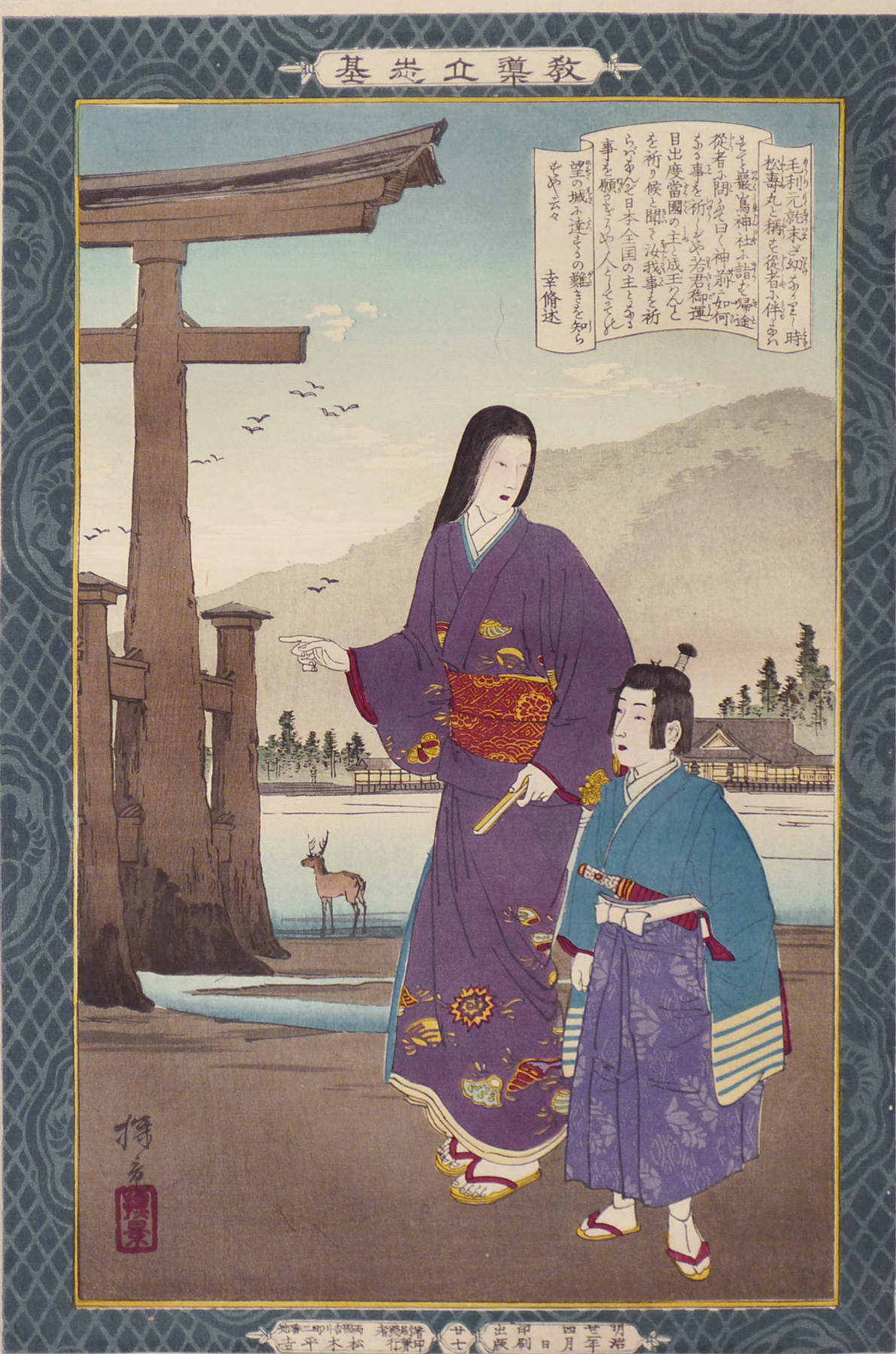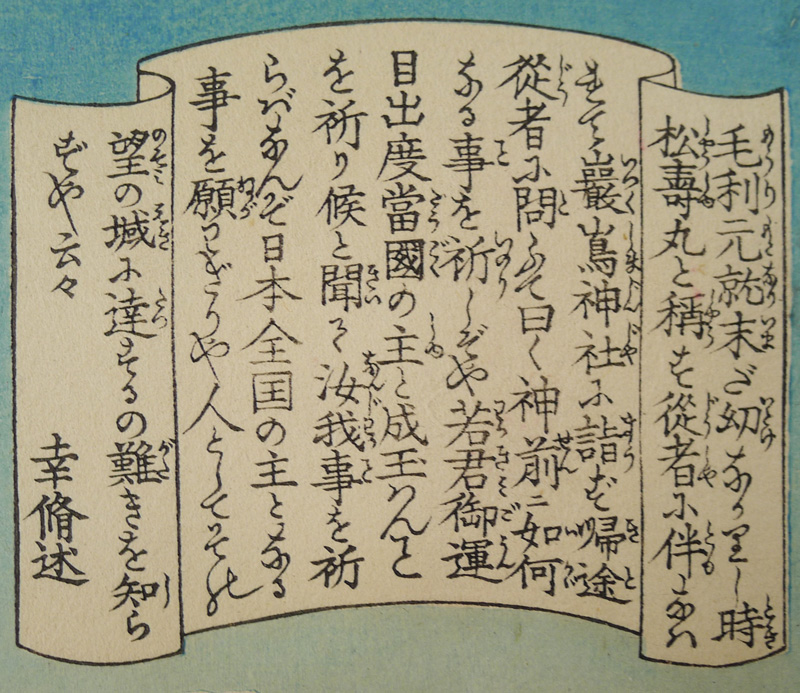About This Print
Print number 廿七 (27)1 in the series Instructive Models of Lofty Ambition picturing the powerful daimyō Mōri Motonari (1497-1571) as a young boy visiting Itsukushima (Miyajima) Shrine with his maidservant, just prior to his coming of age ceremony (genpuku) in 1511. Legend has it that Shōjumaru, Motonari's childhood name, asked a young retainer accompanying him what he had wished for at the shrine. The young retainer replied that he wished for Shōjumaru to become the lord of Aki province. Shōjumaru reprimands the boy, asking why he did not wish for him to become lord of all Japan, as that is a higher goal to meet.Inoue, a student of Kobayashi Kiyochika, contributed thirteen prints to this series. He was to die at the age of 25 in 1889, the year this print was issued.
In 1568 Motonari built a Noh stage at Itsukushima (Miyajima) Shrine as an offering to the shrine.
27 Mōri Shōjumaru (Motonari) 毛利松壽丸(元就)
教導立志基 廿七 毛利松壽丸(元就) 井上探景(安治) 1889年4月
Transcription:
“毛利元就未だ幼(いとけ)なかりし時 松壽丸と稱(称)す 従者に伴なハれて厳嶋神社に詣ず 帰途従者に問ふて曰く 神前に如何なる事を祈しぞや 若君御運目出度當國(当国)の主と成玉ハんことを祈り候 と聞て 汝我事を祈らバなんぞ日本全国の主となる事を願わざりや人としてその望の域に達するの難きを知らずや云々 幸脩 述”
Notes:
1 Numbering of the prints was haphazard during the production of the series. Print numbers were sometimes inadvertently omitted; some prints in the series were never assigned numbers and a few of the same numbers appear on different prints.
The Story of Mōri Shōjumaru
Motonari was born the 2nd son of Mōri Hiromoto at Yoshida in Aki province. He was to go on and become the most powerful daimyō of 16th century Japan. Not only a brilliant commander, carrying out over 200 military campaigns, he was an expert in poetry and the arts. Perhaps his most famous victory was at the Battle of Miyajima in 1555. The Battle of Miyajima was the turning point in a campaign for control of the Ōuchi clan and of Aki Province, a strategically important province for establishing control of western Honshu. It was an important step for the Mōri clan in taking the foremost position in western Japan, and cemented the reputation of Mōri Motonari as a cunning strategist.1Motonari is famous for his deathbed speech to his sons. After ordering that many arrows be brought to him he told his three sons:
'When bound together, these shafts are hard to break, but separately they are easily broken; so, you brothers, unify your mind in order to ensure prosperity by dint of your complete harmony.' Takakage, his third son, remarked thereon: ' Verily strife takes root in avarice; if we only endeavor to shun avarice and to respect duty, what can induce us to quarrel? ' Much pleased with this wise saying, and commending it to be followed by all his progeny, Motonari died." — Yuosa, 'Jozan Kidan,' 1739, torn. xvi. chap. ii.
1 Wikipedia http://en.wikipedia.org/wiki/Battle_of_Miyajima
教導立志基 廿七 毛利松壽丸(元就) 井上探景(安治) 1889年4月
Transcription:
“毛利元就未だ幼(いとけ)なかりし時 松壽丸と稱(称)す 従者に伴なハれて厳嶋神社に詣ず 帰途従者に問ふて曰く 神前に如何なる事を祈しぞや 若君御運目出度當國(当国)の主と成玉ハんことを祈り候 と聞て 汝我事を祈らバなんぞ日本全国の主となる事を願わざりや人としてその望の域に達するの難きを知らずや云々 幸脩 述”
About The Series "Kyōdō risshi no motoi"
Notes:1. This series is variously translated as "Instructive Models of Lofty Ambition," "Foundations of Learning and Achievement," "Foundation of Instruction and Perseverance," "Self-Made Men Worthy of Emulation," "Paragons of Instruction and Success," "Moral of Success," "Examples of Self-Made Leaders," and "Instruction in the Fundamentals of Success." The title in Japanese is sometimes seen as "Kyōdō risshiki or "Kyōdō risshi no moto," in addition to the most commonly seen transliteration of "Kyōdō risshi no motoi".2. For a complete listing of all the prints in the series and additional information please see the article on this site titled Instructive Models of Lofty Ambition.
This series ran between October 1885 and November 1890 and featured a long list of heroes and heroines, from antiquity to contemporary times, who were regarded as standards of moral leadership and self-realization.
Source: Kiyochika Artist of Meiji Japan, Henry D. Smith II, Santa Barbara Museum of Art, 1988, p. 74-75; original research and as footnoted.
This series of 58 prints,1 plus a table of contents sheet (目録), were originally published between October 1885 and November 1890 by the Tokyo publisher Matsuki Heikichi 松木平吉.2 The table of contents sheet issued by the publisher states that "fifty prints make up the complete set (五十番揃)". Three prints not in the initial release were added over the five year publication period, as were five redesigns of original prints, eventually increasing the total print count to 58. The seven artists contributing prints were Kobayashi Kiyochika (1847-1915) [20 prints], Mizuno Toshikata (1866-1908) [16 prints], Inoue Tankei (Yasuji) (1864-1889) [13 prints], Taiso (Tsukioka) Yoshitoshi (1839-1892) [5 prints], Yōshū Chikanobu (1838-1912) [2 prints], Toyohara Kunichika (1835–1900) [1 print], and Hachisuka (Utagawa) Kuniaki II (1835-1888) [1 print]. All the artists, with the exception of Yōshū Chikanobu, are listed in the top scroll of the table of contents sheet. Various colors (including blue, blue/green, and tan/brown) were used for the decorative border, and in 1902 the series was re-issued by Matsuki without borders.
Brief texts contained within a scroll-like cartouche appearing on each print provide historical details. The scroll composer's name is given at the end of the scroll text. The “lofty ambition” of the title is a Confucian concept, originally from Mencius, meaning “righteous determination that would inspire others.” The market for the series probably included former samurai, ambitious youth, and conservative intellectuals.
"[W]hen it was completed in 1890 the publisher was singled out for special recognition by the government for having sponsored such noble subject matter."3
This series ran between October 1885 and November 1890 and featured a long list of heroes and heroines, from antiquity to contemporary times, who were regarded as standards of moral leadership and self-realization.
Source: Kiyochika Artist of Meiji Japan, Henry D. Smith II, Santa Barbara Museum of Art, 1988, p. 74-75; original research and as footnoted.
This series of 58 prints,1 plus a table of contents sheet (目録), were originally published between October 1885 and November 1890 by the Tokyo publisher Matsuki Heikichi 松木平吉.2 The table of contents sheet issued by the publisher states that "fifty prints make up the complete set (五十番揃)". Three prints not in the initial release were added over the five year publication period, as were five redesigns of original prints, eventually increasing the total print count to 58. The seven artists contributing prints were Kobayashi Kiyochika (1847-1915) [20 prints], Mizuno Toshikata (1866-1908) [16 prints], Inoue Tankei (Yasuji) (1864-1889) [13 prints], Taiso (Tsukioka) Yoshitoshi (1839-1892) [5 prints], Yōshū Chikanobu (1838-1912) [2 prints], Toyohara Kunichika (1835–1900) [1 print], and Hachisuka (Utagawa) Kuniaki II (1835-1888) [1 print]. All the artists, with the exception of Yōshū Chikanobu, are listed in the top scroll of the table of contents sheet. Various colors (including blue, blue/green, and tan/brown) were used for the decorative border, and in 1902 the series was re-issued by Matsuki without borders.
This series of 58 prints,1 plus a table of contents sheet (目録), were originally published between October 1885 and November 1890 by the Tokyo publisher Matsuki Heikichi 松木平吉.2 The table of contents sheet issued by the publisher states that "fifty prints make up the complete set (五十番揃)". Three prints not in the initial release were added over the five year publication period, as were five redesigns of original prints, eventually increasing the total print count to 58. The seven artists contributing prints were Kobayashi Kiyochika (1847-1915) [20 prints], Mizuno Toshikata (1866-1908) [16 prints], Inoue Tankei (Yasuji) (1864-1889) [13 prints], Taiso (Tsukioka) Yoshitoshi (1839-1892) [5 prints], Yōshū Chikanobu (1838-1912) [2 prints], Toyohara Kunichika (1835–1900) [1 print], and Hachisuka (Utagawa) Kuniaki II (1835-1888) [1 print]. All the artists, with the exception of Yōshū Chikanobu, are listed in the top scroll of the table of contents sheet. Various colors (including blue, blue/green, and tan/brown) were used for the decorative border, and in 1902 the series was re-issued by Matsuki without borders.
Brief texts contained within a scroll-like cartouche appearing on each print provide historical details. The scroll composer's name is given at the end of the scroll text. The “lofty ambition” of the title is a Confucian concept, originally from Mencius, meaning “righteous determination that would inspire others.” The market for the series probably included former samurai, ambitious youth, and conservative intellectuals.
"[W]hen it was completed in 1890 the publisher was singled out for special recognition by the government for having sponsored such noble subject matter."3
1 The Tokyo Metropolitan Library online collection shows 50 prints and a Table of Contents sheet. The Table of Contents lists the titles of 50 prints. Smith in Kiyochika Artist of Meiji Japan identified 52 prints. I have identified 58 prints from this series including five prints (Ikina, Michizane Sugiwara, Kesa Gozen, Soga Brothers and Hokiichi Hanawa) that were re-designed and re-printed, likely due to damaged or lost blocks.
2 Robert Schaap notes in Appendix II, p. 166 of Yoshitoshi, Masterpieces from the Ed Freis Collection, Chris Uhlenbeck and Amy Reigle Newland, Hotei Publishing, 2011 that the series originally appeared as newspaper supplements.
3 The World of the Meiji Print: Impressions of a New Civilization, Julia Meech-Pekarik, Weatherhill, 1986, p. 122.
1 The Tokyo Metropolitan Library online collection shows 50 prints and a Table of Contents sheet. The Table of Contents lists the titles of 50 prints. Smith in Kiyochika Artist of Meiji Japan identified 52 prints. I have identified 58 prints from this series including five prints (Ikina, Michizane Sugiwara, Kesa Gozen, Soga Brothers and Hokiichi Hanawa) that were re-designed and re-printed, likely due to damaged or lost blocks.
2 Robert Schaap notes in Appendix II, p. 166 of Yoshitoshi, Masterpieces from the Ed Freis Collection, Chris Uhlenbeck and Amy Reigle Newland, Hotei Publishing, 2011 that the series originally appeared as newspaper supplements.
3 The World of the Meiji Print: Impressions of a New Civilization, Julia Meech-Pekarik, Weatherhill, 1986, p. 122.
Print Details
| IHL Catalog | #964 |
| Title or Description | Mōri Shōjumaru 毛利松寿丸 |
| Series | “Instructive Models of Lofty Ambition” (Kyōdō risshiki 教導立志基) [note: series title also listed as 'Kyōdō Risshi no Mōtō' ‘Kyōdō risshi no motoi’, ‘Kyōdō risshi ki’ and variously translated as “Moral of success” or “Foundations of learning and achievement” or “Self-made Men Worthy of Emulation”' or “Examples of Self-made Leaders” or "Paragons of instruction and success"] |
| Artist | Inoue Yasuji (1864-1889) |
| Signature |  |
| Seal | Tankei 探景 seal as shown above |
| Publication Date | April 1889 明治廿二年四月 |
| Publisher | Matsuki Heikichi (松木平吉) proprietor of Daikokuya Heikichi [Marks: seal not shown; pub. ref. 029] click on image to enlarge (from right to left) publishing and printing date: 明治廿二年 四月 日 印刷 出版 [notification delivered, Meiji 22nd year 4th month day] assigned number within series: 廿七 [27] publisher information: 著刷發者 両国吉川町二番地 印兼行 松木平吉 [publisher and printer Ryōgoku Yoshikawachō 2-banchi Matsuki Heikichi] |
| Impression | excellent |
| Colors | excellent |
| Condition | excellent -backed with stiff paper causing minor paper curling; slightly trimmed on sides and bottom |
| Genre | ukiyo-e; rishki-e; kyōiku nishiki-e |
| Miscellaneous | print number 27 (廿七); position 27 in the Table of Contents for the series |
| Format | vertical oban |
| H x W Paper | 14 1/8 x 9 1/4 in. (35.9 x 23.5 cm) |
| Literature | |
| Collections This Print | Tokyo Metropolitan Library 280-K38; British Museum 1906,1220,0.1820 |



